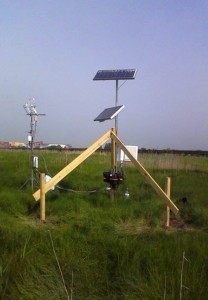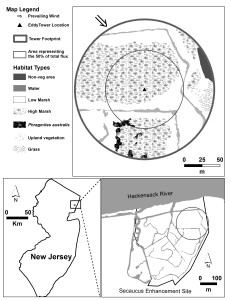Participants: Rutgers, MERI
Problem:
The ability of urban estuaries to sequester carbon dioxide (CO2) and the strength of these sinks are mainly unknown and so is their cumulative effect on global climate change. Measurements of CO2 fluxes are crucial to estimate carbon (C) sink strengths from vegetation. The carbon sequestration service of these ecosystems may represent underutilized CO2 sink that can be potentially enhanced with proper management strategies.
Objective:
Estimate the Net Ecosystem Exchange (NEE) of dominant wetland communities (i.e. Phragmites australis, Spartina alterniflora and Spartina patterns) by measuring CO2 fluxes using the eddy covariance technique concomitant with soil and meteorological measurements.
Strategy:
Vegetation communities will be fitted with an eddy flux tower to continuously measure 3D wind with a sonic anemometer as well as CO2 and H2O concentrations averaged over 30 minutes for an entire year. Supplemental measurements include net radiation, soil moisture, soil heat flux, soil temperature, air temperature, and air humidity which will also be monitored continuously.
Activities:
- Direct measurements of net CO2 fluxes above the wetlands
- Analysis eddy flux measurements and the meteorological measurements
- Analysis of the sensitivity errors
- Calculation of CO2 flux, NEE and GPP modeling from field types
- Model CO2 sink strength indexes for each vegetation community
- Use maps to show the CO2 sequestration strengths
- Identify proper management strategies that may increase CO2 sink strength.
Deliverables:
- NEE (as CO2 sink) index for marsh communities.
- Mapping of CO2 sink strength of the New Jersey Meadowlands wetlands.
Eddy Flux Tower at Secaucus High School Wetlands Enhancement Site
Location of the Eddy Flux Tower along with the current vegetation map.

